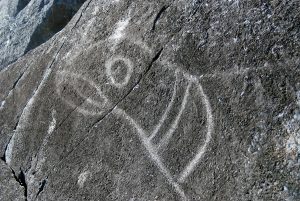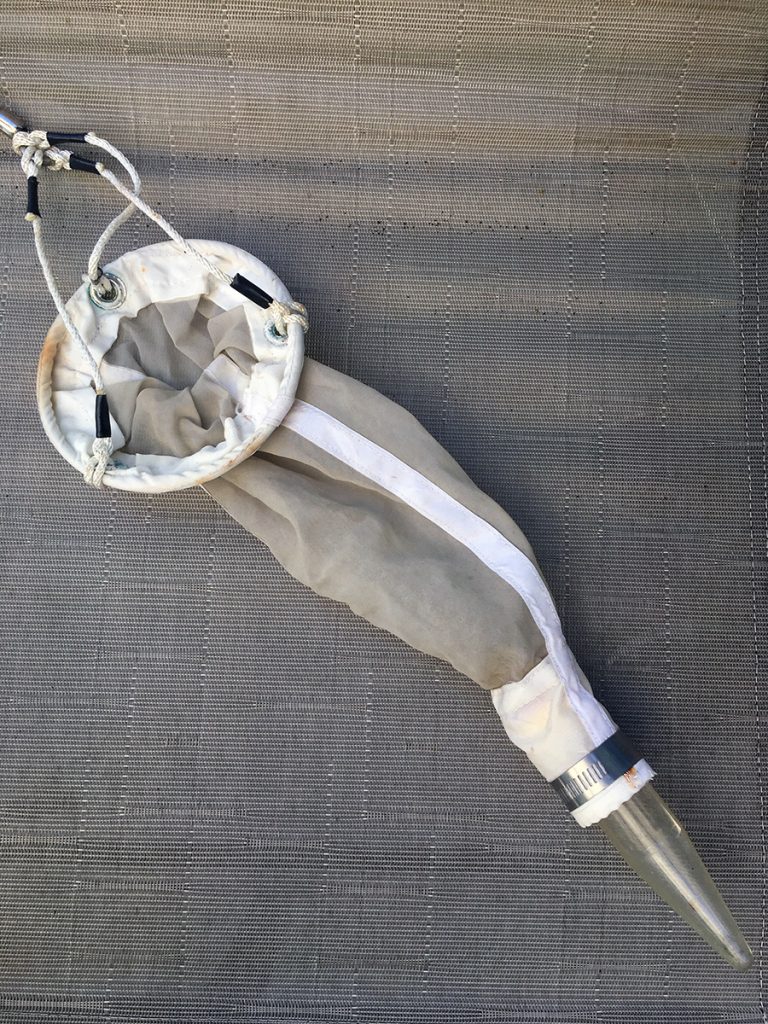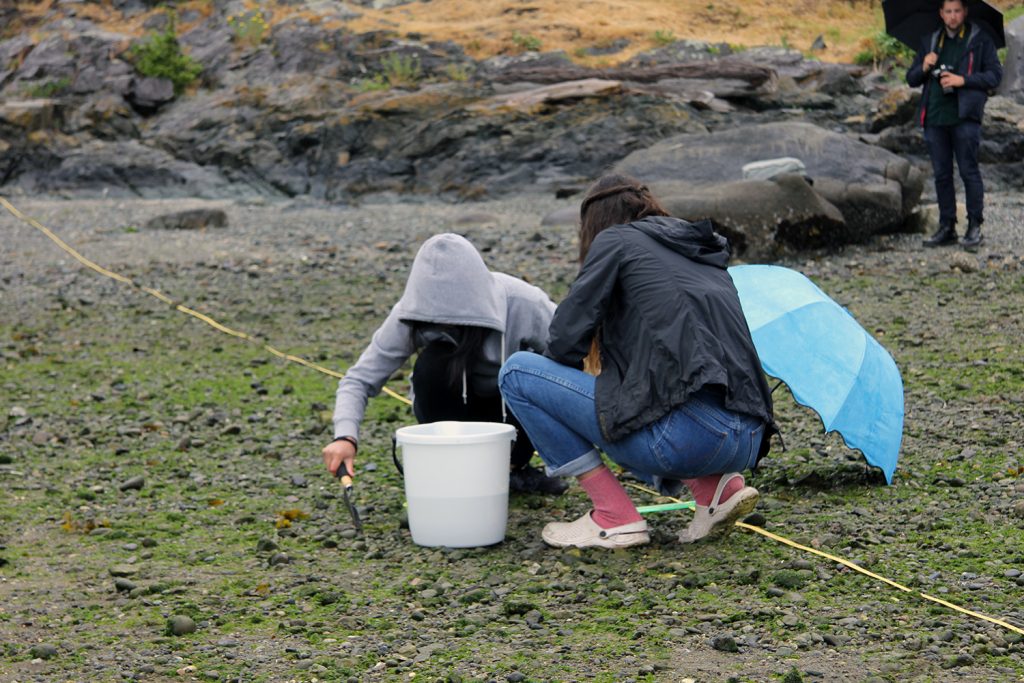Chapter 7 – Cross-Cultural Marine Science: Culturally Inclusive Curriculum for All Learners
David Ashurst; Richard Kool; and Gloria Snively
One of the many challenges facing British Columbia (BC) high school science educators is balancing their teaching strategies to effectively engage all students, while meeting the learning outcomes set by the BC Ministry of Education within the allotted school calendar year. In achieving this balance, pressure is often greatest for educators at the senior levels where students are completing their credits for graduation and facing important final exams. Unfortunately, it is at these senior levels that the highest dropout rate for all students, regardless of culture, is evident (Aikenhead & Michell, 2011; BC Ministry of Education, 2004, 2016a, 2016c; Snively & Williams, 2016).
Currently, one of the largest “at risk” groups are students who identify themselves as Indigenous, a term collectively referring to First Nations, Métis, and Inuit in Canada (BC Ministry of Education, 2016b). Historically, few Indigenous students continue with either math or science into senior secondary education, courses that are required for acceptance in post-secondary college or university (Ministry of Education, Province of British Columbia, 2006; Snively & Williams, 2006). However, when Indigenous students do participate in these upper level math and science courses, they tend to not only pass, but achieve high test scores (Ministry of Education, Province of British Columbia, 2006, 2009, 2016c).
Possessing an understanding of science is important for all students, as they are the future decision makers in their communities. Utilizing ecological and environmental science to encourage Indigenous students to develop a scientific understanding of their environment may be an effective method to encourage their participation in senior science courses. Environmental educators often try to connect humans to their environment through local culture and the interrelationships between human and natural communities (Smith & Williams, 1999). Unlike conventional science education methods which tend to detach humans from the environment, an environmental education program encourages students to develop an affinity to one’s land and place, and engages them to gain an understanding through direct contact with their environment (Louv, 2006; McKeon, 2012; Williams & Snively, 2016). It is the ecological connections and respect developed through environmental education that can provide the backbone for a different kind of scientific inquiry and understanding through which students can make informed community decisions (Kesler, 2015; Roczen, Kaiser, Bogner & Wilson, 2014; Sobel, 1995; Wilson, 1997).
The Cross-Cultural Science Classroom
The authors feel that it is important that the science curriculum reflects the diversity found in our multicultural communities. Unfortunately, most science classrooms and curricula have lacked contributions from any culture outside the dominant Western culture. Aikenhead (1997) recognizes “science” as a subculture of Western culture and that teaching Western Science (WS) only is a form of cultural transmission. The perspectives inherent in WS include cultural facets such as man’s ability to understand the natural world through study and to disseminate the information. Scientific knowledge is pursued for a variety of reasons: “pure” science may be done for its own sake, while “applied” science is often done for a particular purpose—to solve a particular problem, to create a particular innovation—and is often of direct benefit to the discoverer/creator and their sponsors. New knowledge is found through the scientific method and is judged valid when results are predictable, uniform and repeatable (Aikenhead & Ogawa, 2007). Therefore, in educating students in WS, teachers have been presenting a privileged view of Western culture, regardless of students’ cultural background (Aikenhead, 2006). In teaching WS exclusively, educators have marginalized the validity of non-Western cultures’ valuable contributions to other ways of knowing about the world (Cobern & Aikenhead, 1997).
Aikenhead and Jegede (1999) have noted that K-12 school science has its own “culture,” which is not the home culture of most Indigenous students. A cross-cultural education encourages all students to acknowledge this difference and enables students to maintain their own culture, gain awareness of other cultures, and can encourage the extraction of teachings they feel are relevant to their lives. However, at this time, due to the nature of upper level science courses, it is important that students are able to understand WS concepts for exam purposes and to gain entry into university. A key approach to cross-cultural science education is the incorporation of Indigenous Science (IS), which is the knowledge of Indigenous cultures worldwide, developed over time within a cultural framework for understanding one’s world, which tends to connect community, environment, and technology (Ogawa, 1995; Snively & Corsiglia, 2001). Hatcher, Bartlett, A. Marshall, and M. Marshall (2009) refer to the learning of both Western and Indigenous Science—taking advantages of the strengths of each way of knowing—as “Integrative Science” and “Two-Eyed Seeing” (p. 149). For a more complete discussion about how the terms of Western Science and Indigenous Science are used, refer to Chapter 1). Although BC’s new science curriculum (2016b), encourages the recognition and incorporation of IS into science courses it is not, at present, fully integrated into the learning outcome in the high school science curricula.
Traditional Ecological Knowledge and Wisdom
One strategy that educators may use to increase Indigenous student participation in the sciences is through the exploration of a subset of IS known as Traditional Ecological Knowledge and Wisdom (TEKW). Even though the concept of TEKW has various definitions, the overriding principle involves an extensive body of knowledge and practices of various cultures acquired through long-term interdependence with the environment, which is passed down through generations (e.g., Berkes, 1993, 2012; Berkes, Mathias, Kislalioglu, & Fast, 2001; Martin, Roy, Diemont, & Ferguson, 2010; Snively & Corsiglia, 2001). “Traditional wisdom may be thought of as an aspect of IS that focuses on balancing human needs with environmental requirements” and begins with an understanding that “all life forms be respected as conscious, intrinsically invaluable, and interdependent” (Snively & Corsiglia, 2016, p. 92).
TEKW presents a worldview that encourages an understanding of interdependence, long-term resource management, ecological connections, survival skills, culture, and respect that has been recognized as an important source of knowledge by the Government of Canada and others around the world (Berkes, 2012; Johnson, 1992; Pearce, Ford, Willox & Smit, 2015). Introducing all students to TEKW presents them with an alternative cultural view of knowledge and encourages students to respect both their own and other perspectives of science, as well as complementing many cross-curricular aspects, such as First Nations studies, multiculturalism, anti-racism, and environmental education (BC Ministry of Education, 1996, 2016b). Additionally, the new BC science curriculum identifies the importance of local knowledge and a place-based approach to science for all students (BC Ministry of Education, 2016b, through promoting a sense of place within the students’ communities that may be vital to successful Indigenous education (Kawagley & Barnhardt, 1999).
Including TEKW in the science classroom may also promote learning benefits for all students. TEKW, in addition to a WS curriculum, can present students with hands-on, tangible ways of knowing, as well as offering opportunities to engage abstract thinking skills. Including TEKW can also help students, whose prior conceptions do not fall into the realm of Western Science, feel more included. These students need not only be Indigenous students, whose cultural and community views of science and sources of knowledge may differ from WS, but may be students of any culture whose perspectives vary from a Eurocentric background (Snively & Corsiglia, 2001). A cross-cultural approach to science as proposed by Yamada, a Japanese historian of Oriental sciences, as translated and quoted by Ogawa (1995) states: “every society and culture has its own science, and its function is sustaining its mother society or culture” (p. 585). Understanding that science, and thus science education, is part of all cultures, whether implicitly or explicitly recognized, Western science is just one form of the many sciences developed in cultures around the world (Elkana, 1981). In this context, both WS and TEKW could be presented not only for comparison, but also for co-existence, reinforcement, and inclusion into students’ overall worldviews, without forcing students to either build a separate Western scientific worldview, or replace existing aspects of their worldview (Aikenhead, 2001; Aikenhead & Michell, 2011).
Purpose
The purpose of this research and curriculum project was to develop and evaluate a locally based, cross-cultural secondary school marine science program through two cultural perspectives: Indigenous Science and Western Science. The Indigenous Science perspective involved an introduction to concepts and examples of the TEKW of the First Nations peoples of the British Columbia (BC) coast, including the Coast and Straits Salish whom are locally represented in Sooke, BC, on southern Vancouver Island, by the T’Sou-ke, Scia’new, and Pacheedaht. This IS perspective was paired with senior high school level WS and WS field techniques.
Our study focused on the broad question, “Can Western Science and Indigenous Science be taught together in an effective cross-cultural program in which students learn, enjoy, and understand alternative views of science?” In order to answer this question, we examined the knowledge and personal opinions of students before and after a marine science program of studies. Specifically, the study was designed to investigate:
- students’ knowledge and beliefs about WS concepts of local marine ecology and oceanography, such as habitat, the tidal cycle, food energy flow, nutrient cycles, adaptation, zonation, human impacts, environmental monitoring, and resource management,
- student familiarity with local First Nations’ culture and the concepts of IS and TEKW, such as names of local First Nations communities, First Nations stories, and use of natural resources for food, tools, and medicine,
- the extent that students recognized the applicability of science, both Indigenous and Western, as part of their daily life,
- students’ personal opinions regarding their prior science and learning experiences,
- students’ knowledge of ecological topics such as resource use and human impacts on the environment, as well as perceptions of cultural influences upon science, and
- how the students’ knowledge and opinions changed after implementation of the program of studies.
Location and Participants
This study involved the Environmental Studies 11/12 class at Edward Milne Community School (EMCS) in the municipality of Sooke BC, during the fall of 2007. The 19 student participants consisted of eight students of Indigenous ancestry (four males and four females) and 11 of non-Indigenous ancestry (six males and five females) enrolled in the class. The Environmental Studies course, offered as a locally developed course by Sooke teachers, Megan Bondurant and Mike Bobbit, would satisfy student requirements for their Science 11 credit toward graduation, and was a popular option for students due to its local, experiential and hands-on nature, and the use of frequent field trips to natural environments. Due to the nature of Sooke School District’s proximity with First Nations communities, a number of students in the Sooke community have had exposure to the knowledge of First Nations Elders since primary school. Additionally, some of these students had taken First Nations 12, which examined the history of the First Nations in BC and Canada.
EMCS is located close to the Sooke River, which empties into the salty waters of the Sooke Basin. Behind the school are extensive trails through the nearby coastal temperate rainforest. Numerous parks are within easy driving distance, including beautiful East Sooke Park with its windswept rocky coast, rain forest, and sheltered coves. The school has an open design including a full-size grey whale skeleton in the common area (Figure 7.1), and incorporates many carvings and art into the design, reflecting the local T’Sou-ke, Scia’new and Pacheedaht First Nations’ influence (Figure 7.2 and Figure 7.3). Local First Nations culture is reflected in the student population of EMCS, where First Nations students come from any of the three local Nations. A population of approximately 700 students from grade 9-12, come from Sooke as well as from as far away as Port Renfrew, 80 km to the west.
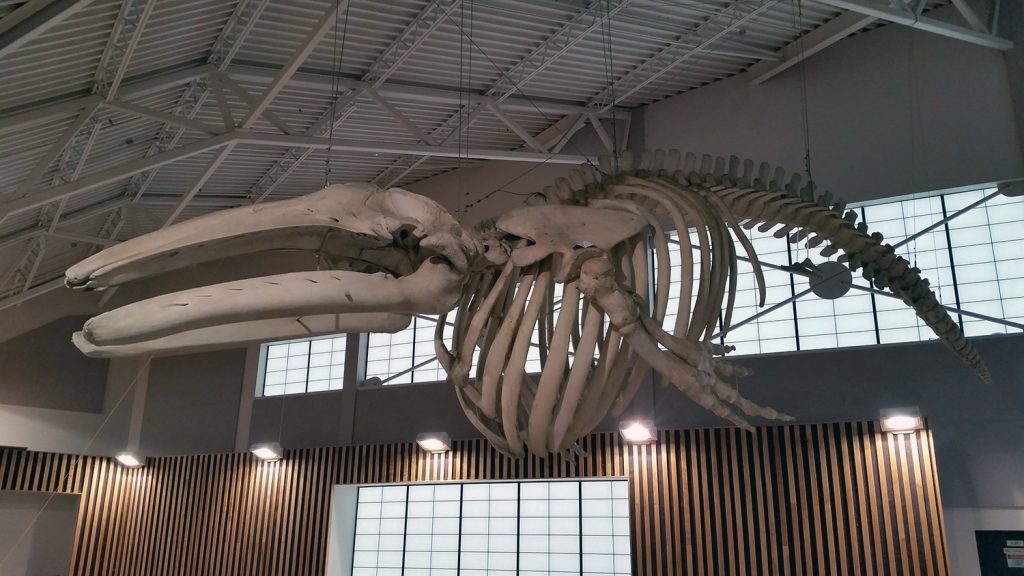
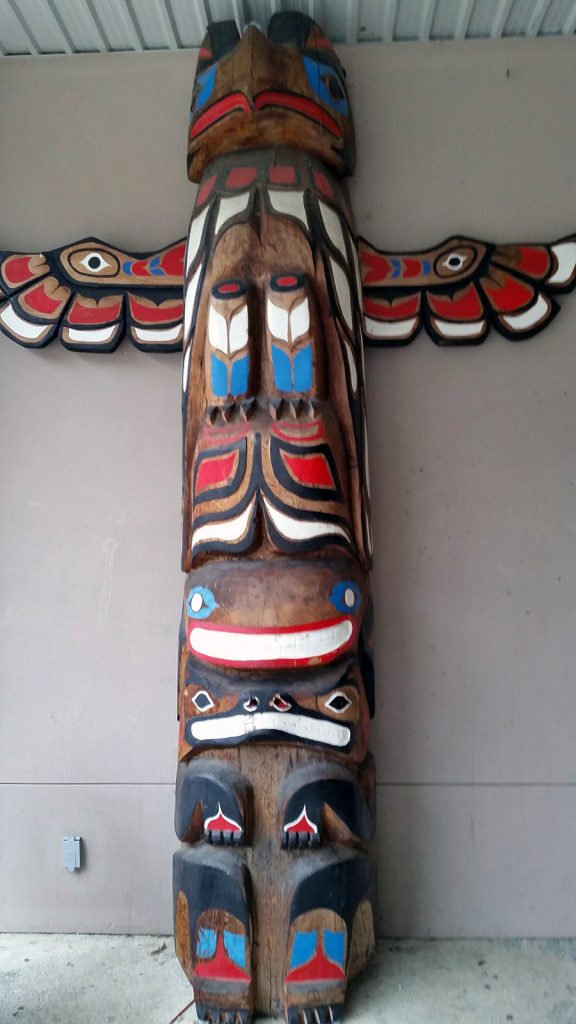

Dave Ashurst was introduced to the class as the temporary teacher/researcher. Although not from the Sooke community, he had previously spent time at EMCS as a temporary teacher and teacher on call. He was familiar with the community and school culture, as well as the class that would be part of the study. As part of his introduction to the class, he explained his own cultural background of European descent and growing up in nearby Victoria, and that, although the class would be learning about Indigenous Science and Traditional Knowledge, he did not have any Indigenous heritage. However, he explained that he had a long history of marine and environmental education, as well as more recent experiences along the coast learning about TEKW from Elders and knowledge holders.
Research Method
The design of the study included the development and application of questionnaire instruments that sought to assess the knowledge and opinions of students, both before and after instruction of the cross-cultural marine science program. Information from a pre-instructional questionnaire provided the authors a baseline quantitative and qualitative assessment of the students’ existing conceptions, beliefs, and opinions about a number of topics to be addressed in this program, including students’ prior personal educational experiences and understandings in science and ecology, such as marine ecology, oceanography and resource uses, in addition to students’ understandings and beliefs of local First Nations culture and TEKW.
The questionnaire (Ashurst, 2009) was based on a standardized questionnaire originally developed by Snively & Sheppy (1991), which had been adapted and shown to be effective in later research projects (e.g., Cummins, 1997; Halls, 2002). For this project, the questionnaire was completed online and targeted students’ knowledge level; background; the local geography, resources, and historical aspects relevant to the District of Sooke; and addressed local ecological features such as the Sooke Basin, the rocky shorelines and coastal temperate rainforest. Other aspects of the questionnaire explored students’ familiarity with local native plant and animal life, Indigenous communities, such as T’Sou-ke and Esquimalt, and locally important resources, such as fishing and logging.
Comprised of three parts, the questionnaire included a Likert-style section that explored feelings and beliefs using ratings from one (strongly disagree) to four (strongly agree). The second section explored students’ knowledge levels through multiple-choice questions, covering various aspects of oceanography, ecology, coastal resources, human impacts and TEK. Then, in the final section students were asked to sketch their local seashore, including drawing and identifying as many organisms as possible, and they were invited to respond to an open-ended questionnaire about how they would approach a scientific marine resource study in their local area.
Effectiveness of the program curriculum was examined through the application of a post-instructional questionnaire, which was administered a week following Ashurst’s cross-cultural marine science program. The questionnaire re-examined students’ opinions on specific topics, and elicited statements describing their feelings toward the program. In addition, the open-ended question on designing a marine study in their locality was re-administered to examine differences in how students acquired and applied their knowledge during the program. Results were assessed and compared statistically to the pre-test results to determine the effectiveness of the program.
Cross-cultural Marine Science Program
A marine science program of three weeks duration was developed in which both WS and TEKW were explored, along with outdoor experiences and cross-cultural learning about various ways of understanding nature. Implementation of the marine science program was designed to coincide with low tides and good weather conditions, during the spring and early summer months.
This program included sessions taught in the classroom (used to present background knowledge and field trip logistics) and during field trips (included several outdoor excursions). In school, classes lasted approximately an hour, while there was an opportunity, twice each week, to take advantage of a double block and lunch hour time slots for field trips lasting two to three hours. Classroom instructional material included presentations by Archer, as well as discussions and group activities exploring various aspects of marine science. The goals of the program incorporated:
- A place-based focus on education,
- An experiential education,
- A cross-cultural exploration of science, focusing on WS and IS,
- Learning about First Nations culture and understanding the importance of TEKW,
- Learning about and practicing various WS methods and techniques used to study the coastal environment,
- Understanding specific WS concepts of marine ecology and oceanography.
Overall, this program focused on the recognition of science as culturally diverse, with hands-on practice in the students’ own communities. This locally specific environmental and ecological education is what Woodhouse and Knapp (2000) refer to as “place-based education” (p. 2), where students’ experiences in nature and their community will lead to educated choices that support cultural and ecological sustainability. Finally, a culturally respectful approach to this program aimed to affect the student’s knowledge, while respecting their beliefs.
Curriculum Explorations
Indigenous Science Concepts
Introducing students to both IS and TEKW was an important aspect of the program. Students were encouraged to recognize that school-based WS is just one of many perspectives on how we can come to understand the world around us. In recognizing how ways of knowing depends on cultural background, students explored the purpose of “science” and how science is influenced by culture.
First Nations’ stories were used to explore concepts in IS and TEKW. Stories present a powerful and integral form of cultural transmission of science and related knowledge. Coastal First Nations stories, such as “Salmon Boy” and “Octopus and Raven,” adapted from the BC coastal Haida and Nuu-chah-nulth nations, respectively were read to students (Caduto & Bruchac, 1991). Guided group discussions were utilized to explore the ecological, cultural, and moral aspects of these stories. “Salmon Boy,” for example, emphasized the importance of respecting one’s natural resources in the same manner one would respect a close relative. This respect, and the careful behaviours around salmon, emphasize how these particular cultures acknowledge that humans are not separate from nature, but are entwined within, and must therefore show proper respect for their environment. Additionally, the tradition of returning the remains of salmon to the river in the same story illustrates the importance of nutrient cycling in the forest, as well as keeping the village clean. In the “Octopus and Raven,” children learn from their Elders through respectful observation and learn that one should always be aware of the tidal rhythms when at the seashore.
Students also examined various “creation” and “flood” stories from several cultures around the world, including Salish, Mayan, Judeo-Christian, Greco-Roman, Japanese, Sumerian, and others, and compared these with each other, as well as WS evidence regarding past events. Students were encouraged to recognize that, in addition to entertainment and moral lessons, some of these “stories” can be seen as a potential source of historical environmental data in a region, especially when corroborated with other sources such as archaeological and geological data. An important aspect of the program was to show how TEKW, including resource use and sustainability, could be used either on its own or complementary to WS.
One example of braiding together TEKW and WS was exploring concepts related to the tidal cycle. Stories connected with the tides such as “Raven and the Man Who Sat on the Tides,” which was adapted from the northern coastal Tlingit (McWilliams, 1996), and “Octopus and Raven” (Caduto & Bruchac, 1991), were read by Ashurst to the class. After reading a story, a guided discussion explored their allegorical nature. For example, “The Man Who Sits on the Tides, who is engrained in habitual behaviours without understanding why, is influenced by Raven who works to change the behaviour of the man from constantly sitting, encouraging the man to regularly stand, releasing the waters he sits upon and creating the tides. Important life lessons about tidal cycles and how knowledge of the tides affected and still affect people’s daily lives in transportation and resource extraction were acknowledged. In these stories, the tides are important for access to food in the tidal zone, but not paying attention to the tidal cycle could prove fatal as Raven found out in “Octopus and Raven” (Caduto & Bruchac, 1991). In the next stage of the instructional program, the students learned to connect the tidal concepts to WS through a study of the cycles of the moon, its gravitational effects upon the oceans, and the intertidal zonation of marine life.
The purpose of blending IS and in particular, the wisdom aspects of TEKW, with WS was to encourage mutual respect for the applicability of both perspectives. It was felt that if both views were taught independently, students might perceive these perspectives as being in contrast instead of appreciating them as complementary perspectives. Although not used in this instructional program and research study, it should be noted that inviting Elders to share locally specific, First Nations stories would have been an even more appropriate approach. However, trying to involve Elders may prove a challenge for educators needing to plan ahead, and possibly placing too much demand on time from local First Nations communities. Additionally, educators need to be aware that utilizing First Nations culture in the classroom may involve understanding certain protocols. For example, specific First Nations families own the intellectual property of the stories, and unless given express permission by the community, it is not appropriate to re-tell these stories.
Marine Ecology and Resources
Marine ecology concepts and processes were explored in the classroom utilizing presentations and activities, which focused on local coastal life. One of the first aspects addressed was to understand and brainstorm the various biotic (living) and abiotic (non-living) factors that influence the lives of marine organisms. These factors were examined with reference to adaptations of life in different intertidal zones and built upon the prior cross-cultural tidal lesson.
In teaching a cross-cultural, ecological program, it is important to acknowledge that although WS and IS have similarities, they do have differences. In their respective ecological worldviews, WS classifies ecological factors into “living” (biotic), and “non-living” (abiotic) components. These biotic components include organisms from the six kingdoms of life recognized by WS biologists (e.g., Cavalier-Smith, 1998, Ruggiero et al., 2015). Abiotic components include environmental factors such as oxygen, water, sunlight, various nutrients and space. However, within the Indigenous worldview (IS) of coastal BC First Nations, as described by Snively (2016), the rocks, trees, fish, streams, sun, and moon, all have consciousness and have the ability to teach lessons to each other and people within this system— all the components of the ecosphere are equally important (Snively & Williams, 2008; Williams & Snively, 2016). Utilizing both of these worldviews can help students of all cultures understand their place within the environment. “Time and again the stories have said that all of the living and nonliving parts of the Earth are one and that people are a part of that wholeness. Today, ecological science agrees” (Caduto & Bruchac, 1988, p. 5).
Thus, the intent of instruction was to provide both Indigenous and non-Indigenous students an understanding of the western scientific concepts of classification and ecosphere, not to replace their existing cultural beliefs. High school examinations test students’ understanding of Western Science concepts, such as their understanding of “living” and non-living,” not their beliefs about living and non-living. The instruction was designed to enable students to negotiate between the science being taught in the classroom and their life-world culture. As Aikenhead and Michell (2011) further clarify “An Indigenous student can understand Darwin’s theory of natural selection without dismissing his or her belief in an Indigenous creation story. Similarly, a non-Indigenous student can understand indigenous spirituality without believing it or dismissing his or her own religious beliefs” (p. 135).
Students explored the intertidal environment, became familiar with tidal cycles and tide zones, and identified a great diversity of marine organisms, utilizing both scientific (Latin binomials) and local names. Back in the classroom, students worked in groups to sort a large set of marine organism pictures and arrows cards into food chains and food webs, using the arrows to show the directional cycle of food energy flow through the ecosystem from the sun, through primary producers (phytoplankton), to higher consumers and predators (seals, sea lions, orca), and back through detritivores and decomposers.
Students were introduced to a survey of intertidal marine organisms and to the WS method of classifying organisms into phyla. Students identified and then classified organisms from the survey into their scientific and local common names. Students worked with identification guides so that they would be able to utilize these effectively during field excursions. Additionally, Indigenous classification systems were discussed, such as classification by utilitarian uses (food berries, medicinal plants) or general morphological classifications (seaweeds, trees, shrubs, grasses). Indigenous classification systems may differ in purpose from WS classification and naming systems in that IS may include articulating relationships between organisms and humans, or between the organisms and their ecological niche. WS often lacks the contextualization in the classification of organisms as WS sees the relationships between organisms as based upon genetic relationships, and, although very accurate in separating species and showing evolutionary relationships, this approach offers no information on how humans might use the organism or any information about its ecology.
One example comparing classification and naming systems can be seen in the Bigleaf Maple (Acer macrophyllum), where the common name and scientific names describes the large leaves (macrophyllum) and connects it to the maple family (Acer). A number of coastal First Nations languages refer to the Bigleaf Maple as what can be translated to “paddle tree,” referring to the common use of the wood for making lightweight canoe paddles, among other tools (Pojar & MacKinnon, 1994). As noted by Snively (2016), “Both classification systems are valid, depending on the context and purpose for which they were constructed, and thus, both should be presented to students in the science classroom” (p. 140). Through perceiving classification with a cross-cultural lens, the various purposes of each system can be recognized, and students can gain an understanding of the utility of varying classification systems.
Students were also introduced to coastal resource management concepts and issues. Western exploitationist and expansionist resource use was compared to long-established Indigenous practices of long-term resource management. Effects of modern fisheries and timber industries were discussed in terms of over-harvesting and water quality degradation. Traditional BC coastal marine resources, such as clams, crabs, sea urchins and a variety of fish species were discussed, in addition to the traditional technology and techniques involved in this harvesting, such as weirs, bentwood hooks and the bull kelp fishing line (Figure 7.4). Modern small-scale traditional resource use, such as the various ways herring are used by Sooke First Nations (Figure 7.5) (Moss, 2016), was introduced into the discussion, showing how IS is still applicable to modern resource management.
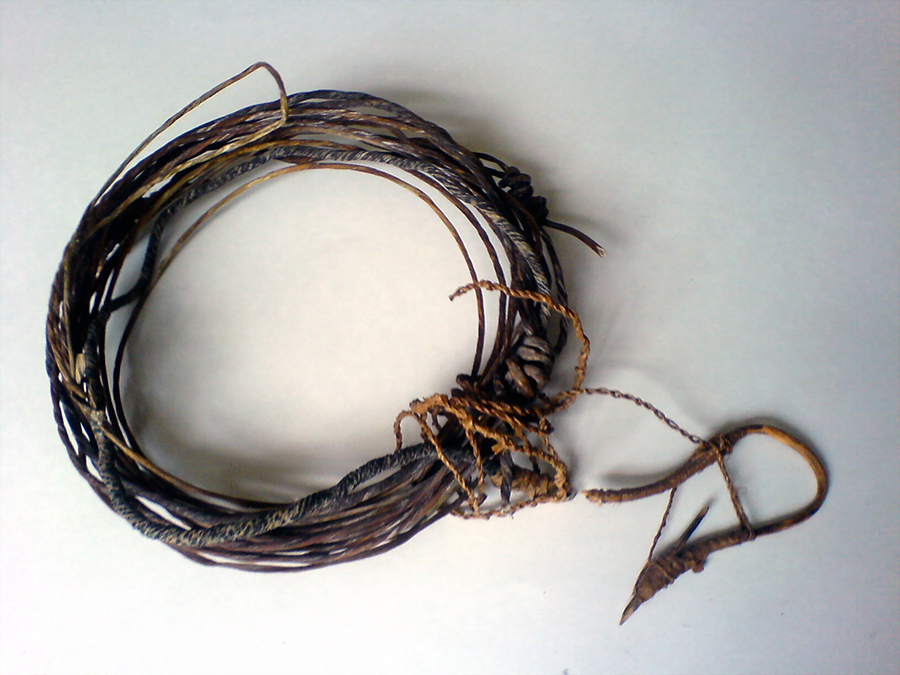
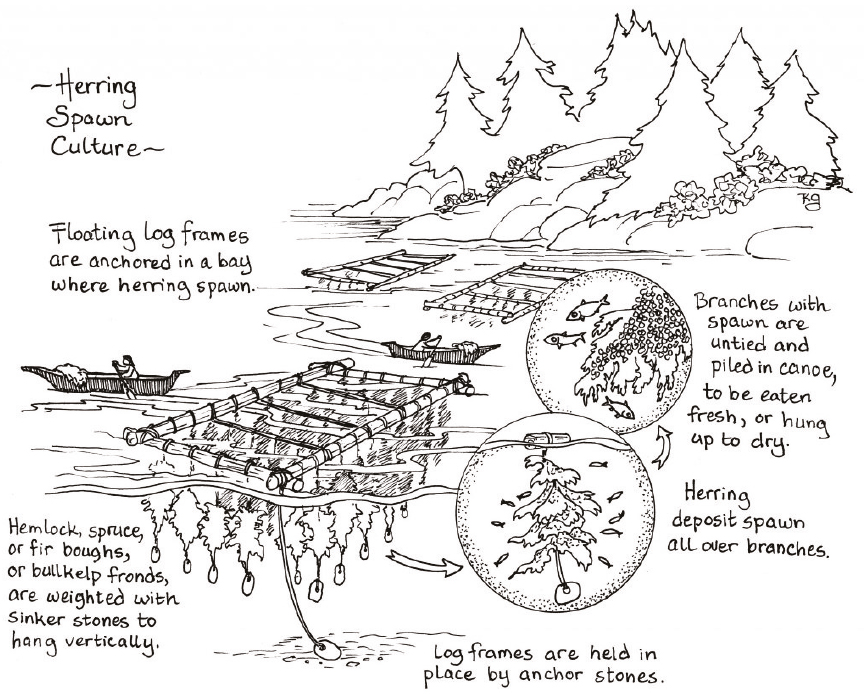
Monitoring the coastal environment
Ashurst felt that introducing students to methods of environmental data collection and research was important and was intended to engage students in the field where they could use modern scientific equipment to collect and analyze data. Students used various techniques in assessing coastal environmental health:
- pH, temperature, salinity, and turbidity (particles suspended in the water column) were ascertained to assess water quality,
- biological quadrat studies and plankton tows helped students to assess biotic conditions.
Students explored how the data collected from these WS techniques could be complemented by IS and how the use of multiple cultural perspectives in science can lead to comprehensive, effective monitoring, and management of our coast.
Field Explorations
An important aspect in developing the EMCS environmental program was the focus on outdoor and experiential learning; the class went on several excursions, each lasting between two to four hours, resulting in approximately half of the instructional time being out of the classroom. In addition to encouraging close observation, questioning and analysis of their surroundings, the field trips were intended to create a sense of wonder and appreciation for the natural environment and diversity of life where the students lived. Informal explorations of the local coastal environment involved many casual teaching moments as students examined and questioned various aspects of the cultural environment, including a First Nations petroglyph located in East Sooke Park (Figure 7.6).
Most field trips had specific purposes, such as practicing skills in environmental sampling and data recording where students utilized scientific equipment. Students learned to use a GPS (a global radio-navigation system) for recording locations. Water quality was analyzed using Secchi disks, refractometers, and hydrometers. Biodiversity was analyzed using plankton nets and quadrats. A detailed study in intertidal mapping of the local seashore was used as a culminating project (Figures 7.7, 7.8, 7.9, 7.10, 7.11 and 7.12). These WS methodologies introduced students to how a marine ecosystem may be monitored for changes, including the collection of baseline data to utilize as a reference point for comparisons with future conditions.

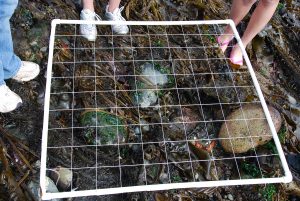

Results
Pre-Instructional Knowledge and Opinions
Western Marine Science. In addressing the effectiveness of the instructional program, it was important to understand the students’ prior knowledge and beliefs about local marine ecology and oceanography concepts such as tidal cycle, adaptation, ecological energy flow, habitat, habitat loss, human impacts, and environmental and resource management. Prior to instruction, these students did not have a strong understanding (<50% correct) in many areas of basic ecology and oceanography, as evidenced through questions that focused on local seashores (Figure 7.12). The low knowledge levels in these areas is consistent with a similar study of grade 4 students by Cummins and Snively (2000) and may indicate that these subjects are not being adequately addressed in many elementary or middle school classrooms (complete findings for this research, including statistical details, can be found in Ashurst, 2009).

Students tended to have poor recognition of specific organisms found in the intertidal zone, and classified organisms in very general groups, such as crabs, snails, and seaweeds. Additionally, the seashore sketch and the knowledge questionnaire found that almost all of the students failed to recognize specific habitats in the intertidal zone (on rocks, under rocks, in tidal pools, or in the sand or mud), the concepts of zonation (see Figure 7.13), and how seaweeds and animals adapt to survive within the intertidal zone.
Although students had previously taken high school science courses and over half of these students had completed senior science classes, almost all of the students were unable to incorporate their previous science experiences into applications of a field ecology study. Students could not identify methodologies and use of any equipment or scientific tests, such as field guides for identification, water quality tests, or use of control sites for comparison, or sampling methods. The most common student response was some form of “I don’t know.”
While students felt that they were knowledgeable in coastal resources and their impacts, the pre-instructional data suggested that this was actually an area of weak understanding. For example, many students did not understand basic resource management definitions, such as conservation and preservation. In fact, students’ understanding of resource management was shown to often be incorrect regarding their perceptions of the status of BC’s fishing industry, and the impacts of this industry and the timber industry upon coastal ecosystems.
Indigenous Culture and Indigenous Science. When Indigenous culture and concepts of TEKW were explored, students appeared to have had some prior experiences with and/or knowledge of these topics (Figure 7.14). Students showed positive opinions and respect toward Indigenous cultures both pre and post instruction and recognized how stories could be used to transfer knowledge and morals. Overall, both Indigenous and non-Indigenous students had some general knowledge about Indigenous cultures, such as where food was collected and how stories were utilized, but this knowledge was not specific to the local area. Additionally, although students had awareness and some ideas about TEKW, such as utilizing plants for food, medicine, and tools, they were unable to express any actual application of this knowledge in designing a research project of effects upon the coastal shoreline.

Students’ Opinions Towards Program Goals. Prior to instruction, students’ overall opinions about concepts such as school science, IS, exploring the environment and how humans impacted the environment, were in strong, positive agreement with the goals of this program. Students’ enjoyed past experiences, recognized a use for science and wanted to learn how to use scientific tools and methods in exploring their environment (Figure 7.14). The students’ positive interests in exploring the marine environment (Figure 7.14), agreed with previous studies conducted by Snively and Sheppy (1991) (grades 5 and 9) and Cummins and Snively (2000) (grade four). Students also showed a respect and understanding of Indigenous culture and a basic understanding of ecological concepts prior to instruction. However, students did not have a strong sense about the cultural influences that relate to WS—they tended to see WS as a subject taught in school and disconnected from their everyday Western cultural experiences.
Pre-Instructional Comparisons. Comparing questionnaire scores between different groups (i.e., gender, cultural, and academic background), we found only three significant pre-instructional trends. Students who had taken a previous grade 11 or 12 science course scored significantly higher for recognition of species diversity in the intertidal zone than those who had not taken a senior science—which may indicate students’ interest in natural science or exposure to the concept of species identification. In addition, the results also show two other statistically significant differences: Indigenous students had a lower estimation of the extent of human impacts upon the environment and lower overall scores on the knowledge questionnaire. These results and other statistical analyses can be found in Ashurst’s Masters thesis (2009).
Addressing Students Alternate Conceptions. Overall, students’ pre-instructional opinions were already positive toward the goals of the program, suggesting that the educational objectives were likely to be accepted and synthesized into their understandings. Many of the students’ alternate conceptions (misconceptions, incorrect understandings, and/or intuitive beliefs) were addressed through classroom and/or field activities. Examples of misunderstandings in the context of WS include:
- 15 of 16 students (94%) believed that seaweeds and kelps are vascular plants with roots and vascular tissue, or closely related to eelgrass (a vascular plant), instead of non-vascularized marine algae. This common and incorrect perception of seaweed was addressed through classroom lessons covering coastal ecology, food webs, and species identification in both the classroom and field;
- From the seashore sketch, all 12 students (100%) earned 50% or less in ecological understandings, representing the intertidal zone as a uniform habitat and did not recognize the importance of zonation in the intertidal zone, or how changes in temperature, elevation, and water cover affects species diversity and location of organisms on a shore. An intertidal survey in the field, examining living and non-living factors at various intertidal zones helped emphasize how different biological factors change due to environmental conditions;
- 13 of 16 students (81%), did not recognize that there are different species of barnacles which exploit different parts of the intertidal zone, and assumed that the size differences of populations of barnacles in different zones was due to food and water availability among the same species. Closer examination and identification of intertidal organisms in their intertidal zones helped students recognize how different species exploit different intertidal zones.
As noted previously, students indicated general group names of organisms spread throughout the intertidal zone. One of the primary purposes of the seashore field excursions was to have students examine the coastal intertidal habitat more closely and recognize the biotic and abiotic factors that affect habitat and species composition throughout their transects. Thus, the research methodology involved designing curriculum, surveying the students’ prior ideas and beliefs, and modifying the instructional input to account for the students’ prior conceptions.
Post-instructional Knowledge and Opinions
Western Marine Science. After instruction, we found that the marine science program induced a number of positive changes within the students’ knowledge and opinions. Overall, students showed a statistically significant pattern of increase in knowledge of all concepts explored (Figure 7.15), with only “Human Impacts” not being statistically significant. After instruction, students understood the biotic and abiotic factors resulting in intertidal zonation of organisms, recognized a greater diversity of species (25% increase score on average), and showed a large improvement in naming specific organisms (38% increase score on average). For example, proceeding from naming generic “seaweeds” to specific types, such as, bull kelp, feather boa, rockweed, and sea lettuce; and generic invertebrate groups to black chitons, keyhole limpets, acorn barnacles, periwinkles, purple shore crabs, and feather duster worms. The improved use of more specific, accepted, non-indigenous common names terminology through experiential field-based explorations was similar to the results found by Cummins and Snively (2000). Students showed a substantial increase in confidence and knowledge in understanding and applying WS methodologies after the instructional program. Prior to instruction, 62% of students were willing to attempt to describe a possible methodology for an ecological impact survey, while 76% attempted this after instruction and they were able to describe the utility and appropriateness of specific methods. Additionally, more students recognized the need to use control sites and samples for comparison with the primary study site. Examples of students utilizing proper methodologies when theoretically testing for impacts of a salmon farm include:
Sample the water from near a salmon farm and sample the water from an area of the ocean where there are no salmon farms. This will tell you the pollution created from them. (Grade 11 student)
Take samples from areas further and closer to the salmon farm and compare the data and make some conclusions from that data and compare it to older data already. (Grade 11 student)
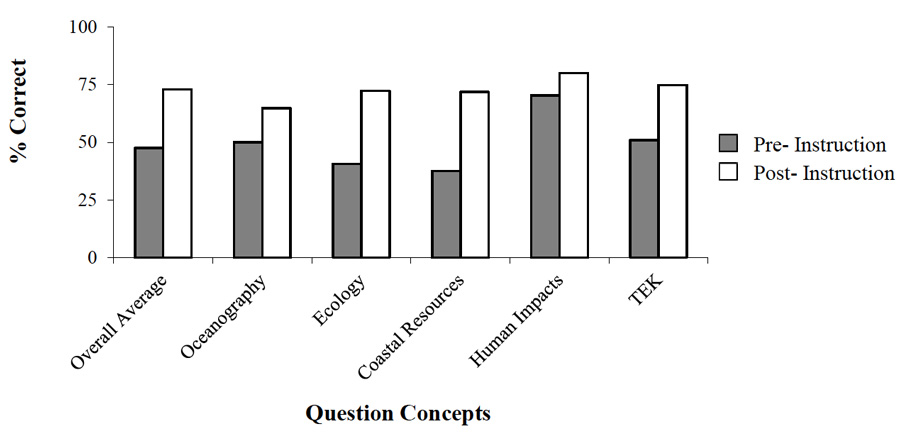
Indigenous Culture and Science. After instruction, students showed increased knowledge and appreciation of IS and other cultural perspectives. Students had an understanding of these concepts prior to instruction (51% average score on TEK based questions); however, after instruction they had developed a significantly more sophisticated knowledge and acceptance of other cultural views of science (Figure 7.15, Figure 7.16, see also Ashurst, 2009). In reference to IS and TEKW, students had more positive opinions about the importance of First Nations stories for moral lessons, as well as its applicability to WS, including environmental and resource management. This improved appreciation was shown where students’ overall opinions in related statements moved towards the “strongly agree” end of the Likert-scale on these topics (Figure 7.16). Increased concrete knowledge and appreciation was also evident as students were able to compare and find complementary strengths between WS and TEKW in ecology and resource management. When asked to design a study looking into the possible environmental effects of introducing a salmon farm into their local waters, students showed an improvement above the pre-instructional study in incorporating both WS and IS, although the improvement was greatest in the WS aspects, such as equipment and methods.
We can measure amounts of animals and population using quadrats. This way we can see [whether] populations have been affected and if food chains are the same. (Grade 11 student)
I would gather traditional knowledge from Elders and base some observations from that point … to compare to the information from the Elders. (Grade 11 student)
I would gather traditional knowledge from Elders and base some observations from that point. Do some sort of experiments and monitor the health of the seashore animals. (Grade 11 student)
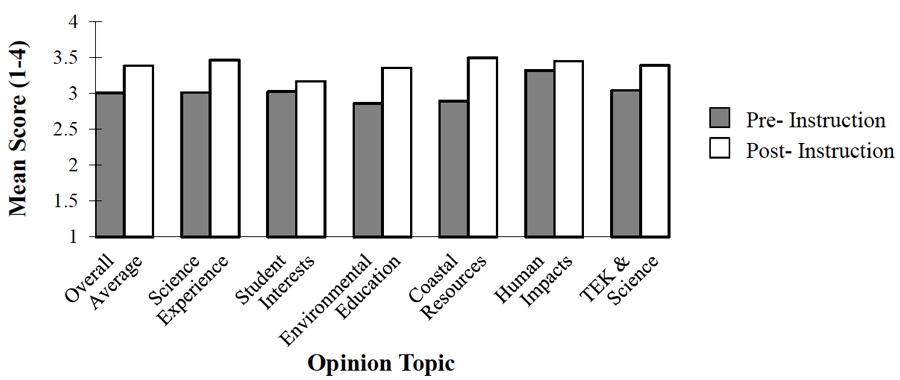
Students’ Opinions Towards Program Goals. After instruction, students’ opinions towards the program and its goals, which were also positive before the program, became more positive after instruction. The Opinion Questionnaire showed significant increases across all categories, except “Student Interests” and “Human Impacts,” where only slight increases were evident (Figure 7.16, see also Ashurst, 2009). The little change in students’ opinions about Human Impacts, however, may be because this aspect was already very high prior to the instructional program, leaving little room to increase. Additionally, students consistently expressed that they enjoyed the hands-on experiential nature of the program, using Western scientific equipment in the field and exploring their local environment.
I enjoyed learning what tools are used for the study of the environment, and how to use them. I cannot think of a situation where I might use them, but I believe in expanding one’s knowledge in any way. (Grade 11 student)
I liked it a lot better than if we were to learn about it in the classroom. Doing our projects in [their] natural habitat is a better [way] to learn about it. (Grade 11 student)
Feelings of Environmental Empowerment. An incidental, but important finding after instruction, was how students’ feelings of empowerment changed positively with regard to their ability to participate in and affect change when confronted with environmental issues. Prior to instruction, students tended to recognize numerous negative human impacts upon the coast, but expressed feelings of helplessness in their ability to contribute to environmental protection. On the pre-instruction Knowledge Questionnaire, 44% of the students answered at least one question with “I don’t know,” where four questions had this as an option; 8 of the 16 students attempted the written response about assessing the impacts of a nearby salmon farm, and 30% of the students felt that their opinions were not valid and that they could not effectively monitor and protect the environment:
Nobody listens to kids. I don’t know. (Grade 11 student)
Someone just needs to smack somebody higher in government… and do something before [it’s] too late… (Grade 11 student)
Students holding opinions such as these, felt that an external force such as government and other professionals, were the only ones that could deal with problems in the community and the environment.
Importantly, after instruction, most students gained confidence in their skills and knowledge, and had the conviction that they could participate in monitoring and providing solutions to the various environmental impacts. After instruction, only one response of “I don’t know” was recorded in the Knowledge Questionnaire. Supporting this gain in confidence, the number of students who attempted the written question about assessing the impacts of a salmon farm increased from 50 % (8 of 16) to 76% (13 of 17) after the program. Additionally, students expressed opinions such as:
I thought that [the program] was pretty interesting and gave me a better/different outlook on the way I looked at the marine units. I now know what I can do to help keep our oceans clean and healthy! (Grade 11 student)
This increased sense of empowerment regarding environmental issues, through confidence in skills and knowledge, agrees with other research regarding the positive effects of environmental studies programs (Smith-Sebasto, 1995).
Comparisons. After instruction, the only notable difference was that students who had taken First Nations 12 (a history course), which is an option to fulfill social studies graduation requirements in BC, showed a 20% higher score in applying TEKW in a situational example than those who didn’t take First Nations 12 (Ashurst, 2009). Although TEKW is not necessarily directly addressed in First Nations 12, this difference may be because these students brought a greater knowledge of First Nations culture and were able to apply this knowledge in their responses. Other than that, there were no large differences between any results of students’ questionnaires, suggesting that all students learned to a similar level regardless of gender or cultural heritage, and were successfully and equally engaged (Ashurst, 2009).
Overall, this project showed that students were able to effectively learn both WS and IS in a holistic marine science program. The cross-cultural nature of the program exposed students to other cultural views of science, and students from all cultures developed an understanding and appreciation for these perspectives. The positive results from this program are encouraging and suggest its potential for developing ecologically literate and environmentally active members to support a sustainable future for many coastal communities.
Examples and Cases into the Science Classroom
Since this study, Ashurst has been incorporating both WS and IS approaches to co-management of resources into the science classroom. For example, the practice of utilizing WS techniques, such as Geographic Information System (GIS) mapping and ecological inventories along with TEKW has been shown to be effective in monitoring and managing resources and local effects of climate change (Reid, et al., 2014; Sanderson et al., 2015). In Canada, the practice of collecting traditional knowledge to support co-management with governing bodies includes work with communities within the Dene Nation for the co-management of northern wild game resources, such as documenting winter moose habitat and usage. For example, ecologists may classify an area as suitable moose habitat based on biological and environmental factors, but experienced Indigenous peoples may recognize more subtle signs, such as lack of evidence of winter usage by moose (droppings, evidence of browse), establishing that the area is not used as winter moose habitat for various reasons, such as deep snow (Johnson, 1992). He noted other examples of co-management including whaling, Pacific walrus and beluga whale management regimes in various communities of the North, from Alaska through to Quebec, and the Inuvialuit wildlife management and harvesting regimes. Both First Nations TEKW and WS have been utilized for yellow-eye rockfish management on the central coast of BC. First Nations Elders and fishermen established baseline data as to size, abundance and habitat of the historical fishery population to compare current First Nations observations with data collected by Department of Fisheries and Oceans Canada (DFO)—a method that can be used to improve the management of the stocks (Eckert, 2017). Furthermore, the DFO specifically incorporates both WS and TEKW into its Integrated Fisheries Management Plans for groundfish, salmon, shellfish, and pelagic fish (Government of Canada, 2017).
The importance of long-term, qualitative data in traditional knowledge for resource management was demonstrated on the north coast of British Columbia when the Nisg̱a’a community recognized subtle behavioural changes of crabs which led to the discovery of environmental contamination by a nearby mine (Corsiglia & Snively, 1997: Snively & Corsiglia, 2016). Studies like this are local examples of larger scale research into the traditional observations of worldwide trends in changing resource reliability due to climate change. Savo, Lepofsky, Benner, Kohfeld, Bailey, & Lertzman (2016) present a multi-country study utilizing both local and traditional knowledge where a majority of “subsistence-oriented” communities noted changes in weather patterns and temperature, as well as changes in seasonality. Savo et al. (2016) found that numerous “subsistence-oriented” communities in the Arctic and sub-Arctic have noted increased temperature and decreased snow in recent times, through both lifetime and multi-generational observations. In tropical and sub-tropical biomes, the majority of these subsistence-oriented groups, including Indigenous communities, had noted sea level rise and changes to tidal patterns. Tidal and weather patterns are not the only noted changes. Inuit in Canada’s Arctic have recognized changes in animal migration and behaviour, increased numbers of mosquitos, new species arriving from southern areas and increased coastal erosion, to name a few (Savo et al., 2016).
Conclusion
The experiential emphasis and local focus of this program encouraged both academically and non-academically inclined students to participate in and enjoy science in a variety of cultural forms. Even if these students choose not to continue with a Western Science education, they had, through the field-based seashore survey, the opportunity to experience how science may be used within their communities. They also had the chance to develop critical thinking skills and a better understanding of the language and methodology of science and its relationship with culture. Students may utilize these skills and knowledge for considering issues related to how they can help reduce their community’s impacts on the local environment. For students who may be more academically inclined, these explorations may have enabled them to experience how professional scientists work in the field, and how environmental science may be applied, putting theory into practice.
Encouraging student recognition of the teachings of both Western Science and Indigenous Science may shift the cultural perceptions of what science is, and who does science. The cross-cultural aspects of the program seemed to be crucial in encouraging success of both Indigenous and non-Indigenous students. Although many students already had positive views of Indigenous culture prior to instruction, the experiences seemed to help to develop a deeper and more concrete understanding about the importance of this cultural knowledge and how Traditional Ecological Knowledge and Wisdom could be important in modern ecological sciences for all students. For example, prior to instruction, students may have known that Indigenous stories held moral and environmental lessons, however after instruction, all students’ experiences included direct examples of the lessons within these stories such as respect for the intertidal organisms, or an improved understanding of the tidal cycles. Indigenous students saw First Nations’ stories presented along with Western Science concepts such as tidal movements, intertidal zonation, sustainability, and research methodologies. This braiding of cultures in the scope of science hopefully reinforced the relevance of their cultural perspectives and the use of Western Science, embracing “two-eyed seeing” (Hatcher, et al., 2009; McKeon, 2012).
This incorporation of First Nations culture appeared effective with the Indigenous students within the program. The equality of knowledge and opinions shown by students after the program, regardless of ancestry and gender, suggests that this culturally inclusive program was equally beneficial for all learners. This cross-cultural factor is important to recognize, as most school science programs do not address issues of cultural equality in learning.
Many First Nations communities along the coast of BC still utilize their natural resources such as forests and fisheries, and these resources require monitoring and management. The majority of scientists employed to monitor these resources are non-Indigenous and often have few, if any, personal relationships with the local community. However, an important intention of the marine-focused environmental program utilized in this project was to engage Indigenous students in active, outdoor, scientific inquiry of and in their local environment. Ideally, this place-based approach to teaching can lead to students becoming educated and engaged members of their communities, making conscientious decisions that support their culture, community, and environment.
Local community management of resources has important implications for BC First Nations communities. Currently, groups such as Ecotrust Canada work with Indigenous communities to aid in mapping and understanding their local resources. Project managers, such as the researcher’s brother, Chris Ashurst, who worked with various communities in efforts to identify and map cultural and natural resources, note the importance of having more Western Science trained First Nations community members who understand the principles of resource management and sustainability (personal communication, July 2004). Increased participation and success of Indigenous students in math and science allows for the possibility of increased opportunities for these students to work directly with their own communities, utilizing Western Science and Indigenous Science in resource management and scientific study. Importantly, future Indigenous professionals (biologists, geologists, and engineers) are more likely to acknowledge cultural aspects of these resources and incorporate these uses into management plans.
An important outcome of this program was that all students developed an increased environmental and cultural understanding of their local environment and feel that they have the ability to positively influence future decisions and events. As educators, we believe that it is important to teach students more than just the recognition of the numerous negative impacts that humans have upon the environment, but instead, to also nurture a feeling of personal empowerment to address such issues. The influx of negative media about global environmental issues has the potential to make students feel powerless and defeated in the face of overwhelming environmental degradation. Educators need to demonstrate to students that there is hope, that Indigenous cultures have the potential to give insight and guidance to environmental ethics and understanding, and that individuals and groups have the potential to make positive differences in protecting and sustaining their local communities and environments.
REFERENCES
Aikenhead, G.S. (1997). Toward a First Nations cross-cultural science and technology curriculum. Science Education, 81(2), 217-238. https://doi.org/10.1002/(SICI)1098-237X(199704)81:2<217::AID-SCE6>3.0.CO;2-I
Aikenhead, G.S. (2001). Integrating western and Aboriginal science: Cross-cultural science teaching. Research in Science Education, 31(3), 337-355. https://doi.org/10.1023/A:1013151709605
Aikenhead, G.S. (2006). Science education for everyday life: Evidence-based practice. Ways of knowing in science and mathematics. New York, NY: Teachers College Press.
Aikenhead, G.S., & Jegede, O.J. (1999). Cross-cultural science education: A cognitive explanation of a cultural phenomenon. Journal of Research in Science Teaching, 36(3), 269-287. https://doi.org/10.1002/(SICI)1098-2736(199903)36:3<269::AID-TEA3>3.0.CO;2-T
Aikenhead, G.S. & Michell, H. (2011). Bridging cultures: Indigenous and scientific ways of knowing nature. Toronto, ON: Pearson Canada.
Aikenhead, G.S., & Ogawa, M. (2007). Indigenous knowledge and science revisited. Cultural Studies of Science Education, 2(3), 539-620. https://doi.org/10.1007/s11422-007-9067-8
Ashurst, D. (2009). Promoting sense of place and culture in science: a study of the effectiveness of a cross-cultural, marine science curriculum through experiential exploration (M.A. Thesis). University of Victoria, Victoria, BC. Retrieved from http://hdl.handle.net/1828/1688
Berkes, F. (1993). Traditional ecological knowledge in perspective. In J. T. Inglis (Ed.), Traditional ecological knowledge: Concepts and cases (pp. 1-9). Ottawa, ON: International Program on Traditional Ecological Knowledge/International Development Research Centre (IRDC) Books.
Berkes, F. (2012). Sacred Ecology (3rd edition). New York, NY: Routledge.
Berkes, F., Mathias, J., Kislalioglu, M., & Fast, H. (2001). The Canadian arctic and the Oceans Act: The development of participatory environmental research and management. Ocean & Coastal Management, 44(7/8), 451-469. https://doi.org/0.1016/S0964-5691(01)00060-6
British Columbia Ministry of Education (1995). Science K-7 integrated resource package. Victoria, BC: Author.
British Columbia Ministry of Education (1996). Science 8-10 integrated resource package. Victoria, BC: Author.
British Columbia Ministry of Education. (2004). Six-year completion rates. Victoria, BC.
British Columbia Ministry of Education. (2006). Aboriginal report- 2005/06: How are we doing? Victoria, BC: Aboriginal Enhancements Branch.
British Columbia Ministry of Education. (2009). Aboriginal report: How are we doing? Retrieved from http://www.bced.gov.bc.ca/abed/perf2008.pdf
British Columbia Ministry of Education. (2016a). Six-Year Completion and Grade 12 Graduation Rates – 2015/16 Province – Public and Independent Schools Combined. Retrieved from http://www.bced.gov.bc.ca/reports/pdfs/graduation/prov.pdf
British Columbia Ministry of Education. (2016b). Building Student Success – BC’s New Curriculum. Retrieved from https://curriculum.gov.bc.ca/ . Archived in Wayback Machine https://web.archive.org/web/20160409013324/https://curriculum.gov.bc.ca/
British Columbia Ministry of Education. (2016c). Aboriginal Report 2012/2013-2016-17. How Are We Doing? Retrieved from http://www.bced.gov.bc.ca/reporting/systemperformance/16. Archived at https://web.archive.org/web/20171007133336/http://www.bced.gov.bc.ca/reports/pdfs/ab_hawd/Public.pdf
Caduto, M. J., & Bruchac, J. (1988). Keepers of the earth: Native American stories and environmental activities for children. Golden, CO: Fulcrum Publishing.
Caduto, M. J., & Bruchac, J. (1991). Keepers of the animals: Native American stories and wildlife activities for children and teacher’s guide. Golden, CO: Fulcrum Publishing.
Cavalier-Smith, T. (1998). A revised six-kingdom system of life. Biological Reviews, 73, 203–266. https://doi.org/10.1111/j.1469-185X.1998.tb00030.x
Cobern, W.W. & Aikenhead, G. (1997). Cultural aspects of learning science. In K. Tobin & B. Fraser (Eds.), International handbook of science education. Dordrecht, NLD: Kluwer Academic Publishers.
Corsiglia, J., & Snively, G. (1997). Knowing home: Nisga’a traditional knowledge and wisdom improve environmental decision-making. Alternatives Journal. 32(3), 22-27.
Cummins, S.A. (1997). The effects of experiential learning on grade four children’s knowledge of marine ecology, their attitudes towards the ocean, and their stances towards marine resource issues (M.A. thesis). University of Victoria, Victoria, BC.
Cummins, S.A., & Snively, G. (2000). The effect of instruction on children’s knowledge of marine ecology, attitudes toward the ocean, and stances toward marine resource issues. Canadian Journal of Environmental Education. 5(Spring), 305-324. Retrieved from https://cjee.lakeheadu.ca/article/view/315
Eckert, L. (2017). Towards indigenous marine management: A case study of yelloweye rockfish on the central coast of British Columbia (M,Sc. thesis), University of Victoria, Victoria, BC. Retrieved from http://hdl.handle.net/1828/8060
Elkana, Y. (1981). A pragmatic attempt at an anthropology of knowledge. In E. Mendelsohn & Y. Elkana (Eds.), Science and cultures. Sociology of the sciences, Volume 5 (pp. 1–76). Dordrecht, NLD: Reidel.
Government of Canada, Fisheries and Oceans Canada, Communications Branch (2017). Integrated Fisheries Management Plans. Retrieved from http://www.pac.dfo-mpo.gc.ca/fm-gp/ifmp-eng.html
Halls, S.R. (2002). The Courtenay River estuary: Marine science curriculum development from a constructivist perspective (M.Ed. thesis). University of Victoria, Victoria, BC.
Hatcher, A., Bartlett, C., Marshall, A., & Marshall, M. (2009). Two-eyed seeing in the classroom environment: Concepts, approaches, and challenges. Canadian Journal of Science, Mathematics and Technology Education, 9(3), 141-153. https://doi.org/10.1080/14926150903118342
Johnson, M. (Ed.). (1992). Lore: Capturing traditional environmental knowledge. Hay River, NWT: International Development Research Centre.
Kawagley, A. O., & Barnhardt, R. (1999). Education Indigenous to place: Western science meets Native reality. In G. A. Smith & D. R. Williams (Eds.), Ecological education in action: On weaving education, culture, and the environment (pp. 117-140). New York, NY: SUNY Press.
Kesler, B. (2015). Learning naturally: An inquiry study of streams in Hawaii. Bank Street Occasional Paper Series, 2015 (33), 76-94. Retrieved from http://educate.bankstreet.edu/occasional-paper-series/vol2015/iss33/8
Louv, R. (2006). Last child in the woods: Saving our children from nature-deficit disorder. Chapel Hill, NC: Algonquin Books.
McWilliams, B. (1996). Raven and the tides. Retrieved from http://www.eldrbarry.net/rabb/rvn/r_tide.htm
Martin, J., Roy, E., Diemont, S., & Ferguson, B. (2010). Traditional Ecological Knowledge (TEK): Ideas, inspiration, and designs for ecological engineering. Ecological Engineering, 36(2010), 839-849. https://doi.org/10.1016/j.ecoleng.2010.04.001
McKeon, M. (2012). Two-eyed seeing into environmental education: Revealing its “natural” readiness to indigenize. Canadian Journal of Environmental Education (CJEE), 17, 131-147. Retrieved from https://cjee.lakeheadu.ca/article/view/1071
Moss, M. L. (2016). The nutritional value of Pacific herring: An ancient cultural keystone species on the Northwest Coast of North America. Journal of Archaeological Science: Reports, 5, 649-655. https://doi.org/10.1016/j.jasrep.2015.08.041
Ogawa, M. (1995). Science education in a multiscience perspective. Science Education, 79(5), 583-593. https://doi.org/10.1002/sce.3730790507
Pearce, T., Ford, J., Willox, A. C., & Smit, B. (2015). Inuit Traditional Ecological Knowledge (TEK), subsistence hunting and adaptation to climate change in the Canadian Arctic. Arctic, 68(2), 233-245. https://doi.org/10.14430/arctic4475
Pojar, J., & MacKinnon A. (1994). Plants of coastal British Columbia. Vancouver, BC: Lone Pine Publishing.
Reid, M. G., Hamilton, C., Reid, S. K., Trousdale, W., Hill, C., Turner, N.,…Matthews, H. D. (2014). Indigenous climate change adaptation planning using a values-focused approach: A case study with the Gitga’at Nation. Journal of Ethnobiology, 34(3), 401-424. https://doi.org/10.2993/0278-0771-34.3.401
Roczen, N., Kaiser, F.G., Bogner, F.X., & Wilson, M. (2014). A competence model for environmental education. Environment and Behavior, 46(8), 972-992. https://doi.org/10.1177/0013916513492416
Ruggiero, M. A., Gordon, D. P., Orrell, T. M., Bailly, N., Bourgoin, T., Brusca, R. C., . . . Kirk, P. M. (2015). A higher level classification of all living organisms. PLoS One, 10(4), e0119248. https://doi.org/10.1371/journal.pone.0119248
Sanderson, D., Picketts, I. M., Déry, S. J., Fell, B., Baker, S., Lee‐Johnson, E., & Auger, M. (2015). Climate change and water at Stellat’en First Nation, British Columbia, Canada: Insights from western science and traditional knowledge. The Canadian Geographer/Le Géographe Canadien, 59(2), 136-150. https://doi.org/10.1111/cag.12142
Sanger, M. (1997). Sense of place and education. Journal of Environmental Education, 29(1), 4-7.
Savo, V., Lepofsky, D., Benner, J. P., Kohfeld, K. E., Bailey, J., & Lertzman, K. (2016). Observations of climate change among subsistence-oriented communities around the world. Nature Climate Change, 6(5), 462-473. https://doi.org/10.1038/nclimate2958
Smith, G. A., & Williams, D. R. (1999). Introduction: Re-engaging culture and ecology. In G. A. Smith, & D. R. Williams (Eds.), Ecological education in action, (pp. 1-18). Albany, NY: State University of New York Press.
Smith-Sebasto, N. (1995). The effects of an environmental studies course on selected variables related to environmentally responsible behavior. Journal of Environmental Education, 26(4), 31-36. https://doi.org/10.1080/00958964.1995.9941449
Snively, G. (1983). Exploring the Seashore in British Columbia, Washington and Oregon. Vancouver, BC: Gordon Soules Book Publishers.
Snively, G. (1995). Bridging traditional science and western science in the multicultural classroom. In G. Snively, & A. MacKinnon (Eds.), Thinking globally about mathematics and science education, (pp. 53-75). Vancouver, BC: UBC Research and Development Group.
Snively, G. (2016). When uncles become killer whales: Bridging Indigenous science with Westerns science and worldviews. In G. Snively & L. Williams (Eds.), Knowing Home: Braiding Indigenous Science with Western Science, Book 1 (pp. 129-146). Victoria, BC: University of Victoria. Retrieved from https://pressbooks.bccampus.ca/knowinghome/
Snively, G., & Corsiglia, J. (2001). Discovering Indigenous science: Implications for science education. Science Education, 85(1), 6-34. https://doi.org/10.1002/1098-237X(200101)85:1<6::AID-SCE3>3.0.CO;2-R
Snively, G. & Corsiglia, J. (2016). Indigenous science: Proven, practical and timeless. In G. Snively & Williams, L. (Eds.), Knowing Home: Braiding Indigenous Science with Western Science, Book 1 (pp. 86-104). Victoria, BC: University of Victoria. Retrieved from https://pressbooks.bccampus.ca/knowinghome/
Snively, G., & Sheppy, J. (1991). The kids are saying “Save our endangered oceans.” Current: The Journal of Marine Education, 10(2), 14-20.
Snively, G., & Williams, L. (2006). The Aboriginal knowledge and science education research project. Canadian Journal of Native Education, 29(2), 229-244.
Snively, G.J., & Williams, L.B. (2008). Coming to know: Weaving Aboriginal and Western science knowledge, language, and literacy into the science classroom. Educational Studies in Language and Literature, 8(1), 109-133.
Snively, G., & Williams, L. (Eds.). (2016). Knowing home: Braiding Indigenous science with Western science, Book 1. Victoria, BC: University of Victoria. Retrieved from https://pressbooks.bccampus.ca/knowinghome/
Snively, G., & Williams, L. (2016). Why transforming the science curriculum is necessary for Aboriginal students. In G. Snively & L. Williams (Eds.), Knowing home: Braiding Indigenous science with Western science, Book 1 (pp.13-34) Victoria, BC: University of Victoria. Retrieved from https://pressbooks.bccampus.ca/knowinghome/
Sobel, D. (1995). Beyond ecophobia: Reclaiming the heart in nature education. Orion, 38(4), 18-22.
Twenge, J. M., Zhang, L., & Im, C. (2004). It’s beyond my control: A cross-temporal meta-analysis of increasing externality in locus of control, 1960-2002. Personality & Social Psychology Review, 8(3), 308-319.
Williams, L. & G. Snively. (2016). “Coming to know”: A framework for Indigenous science education. In G. Snively & L. Williams (Eds.), Knowing Home: Braiding Indigenous Science with Western Science, Book 1 (pp. 129-146). Victoria, BC: University of Victoria. Retrieved from https://pressbooks.bccampus.ca/knowinghome/
Wilson, R. (1997). Special places for young children. Retrieved from http://www.bgci.org/education/article/280/
Woodhouse, J. L., & Knapp, C. E. (2000). Place-based curriculum and instruction: Outdoor and environmental education approaches: ERIC Digest. ERIC Clearinghouse on Rural Education and Small Schools, 1-8. Retrieved from ERIC database. (ED448012).

